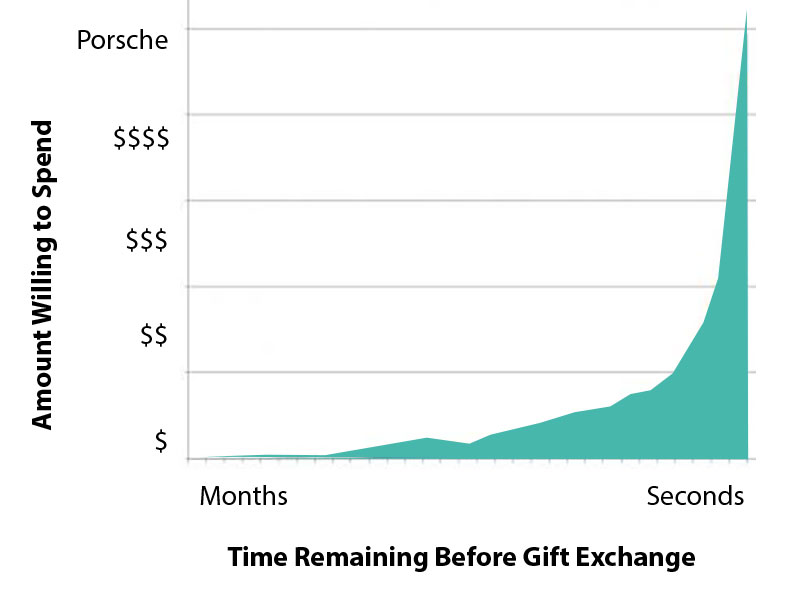Holiday Shopping and the Patterns of the Desperate
So much focus from many of our clients goes into the holiday season and trying to grab as large of slice as is possible from the consumer-shopping pie. It seems like we can never start early enough (I know, I know…). Planning will being mid-year and by August/September higher-volume players have end-of-year promotional planning underway and during October things are oftentimes quite baked.
Yet, when we get down to the few days prior to the actual holiday, most of the corporate focus shifts to the mentality of “well, at this point the dice are cast, let’s see how we do” and much of the heat goes down. Focus shifts. Things move on…
Here’s the odd thing about all of this… consumers in general, don’t map to that pattern. When it comes to the timeline of consumers thinking about and purchasing gifts, let’s look at some statistics…
Gift Shopping by the Numbers
A survey of 2,000 Americans showed 35% of Americans say they tend to buy a gift for somebody at a store WHILE ON THE WAY TO EXCHANGE GIFTS!
Oh, we all have good intentions… 56% of those surveyed say they feel the need to give their partner “the perfect gift.”
And 33% fear the gift that they buy someone will make the person question how well they know them…
46% fear the gift will be perceived as “cheap.”
So, let’s take all of this data and put it into a formula:
Gift Reception Pressure * Fear * Time = $$$
Let’s plug in some values to this equation:
- Low pressure * low fear * lots of time = $
- Low pressure * low fear * no time = $$
- High pressure * high fear * lots of time = $$$
- High pressure * high fear * no time = $$$$
We’re just playing around here with these formulas (don’t ask us to build rockets), but if you look at what the data suggests you would end up with a graph that looks something like a hockey stick.
From Coke to Christmas we Second-guess and Push of Decisions Until the Last Minute
In the soft drink industry, research shows that the vast majority of purchase decisions are at the exact moment the purchase is occurring. Meaning, as you reach for the 12-pack at the grocery store, as you order your drink in the restaurant when you’re about to push the button on the vending machine… you look left and right one last time before you purchase to make sure “you’re feelin’ it” – diet or regular, Pepsi or cherry Pepsi, Coke or Jack and Coke, etc.
How Companies Can Create Win-Win Scenarios with their Customers
There are a lot more statistics we can throw at you, but a CensusWide survey uncovered a couple of interesting tid-bits of data… such as, 42.2% of women surveyed would be “happy” to receive credit at their favorite shops; and 32.3% of men actually want gift vouchers for Christmas.
This means that if you have a pre-conceived notion that “oh, it’s too late to push XYZ now, we’re only a few days from Christmas.” You’re wrong.
During the end game, as we are days and even hours away from a gift exchange, has a person already bought a gift from their friend or loved one? Possibly. Are they second-guessing that they bought “enough” or “the right thing?” Statistically, yes, that is exactly what is happening in a large number of these instances.
For both your male and female consumer base, email and onsite marketing tactics can help facilitate last-minute “hint” channels for friends and loved ones.
Enable your customers that want to hedge a gift they are second-guessing or are looking for an “add-on gift” to increase the number of things for their recipient to open. Encourage them that their friend or loved one will love something from one of their favorite shops – even if it’s a voucher – and provide gift certificates that look great when you print them out.
Gift certificates are easy to purchase, can be bought immediately, can be purchased varying price points, and be printed on demand.
We’ve had clients say to us, “gift certificates? Nobody is going to buy that because our product is XYZ…” All we can point to is experience and from golf to car rental we’ve seen clients happily surprised to see the volume available by catering to this last-minute gift-buying approach.
Of course, you still need to plan for the full season and start as early as you usually do every year… our only point here is this – when so much time and attention is rightfully put on the time leading up to the holiday, in terms of marketing and promotion, a significant amount of time, strategy, and tactics should also be put on end game strategy seeking to leverage the last-minute buying habits of the American consumer.




